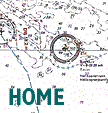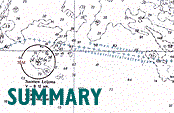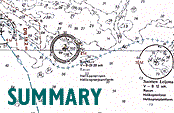 |
Accident
- The ro-ro passenger ferry ESTONIA sank in the northern Baltic Sea during
the early hours of 28 September 1994. Of the 989 people on board, 137
survived. All 95 victims recovered from the sea have been identified and
757 people are still missing.
Weather
- The wind at about 0100 hrs at the site of the accident was south-westerly,
18-20 m/s, and the significant wave height was about 4 m.
- At the time of the accident the ESTONIA was encountering the waves on
her port bow.
- The wave-induced motion made several passengers seasick but the
situation on board was not exceptional.
Ship's condition
- The vessel was seaworthy and properly manned.
- The cargo was secured to normal standard and the visor was properly
closed and secured on departure.
- The vessel had a starboard list of about one degree when she gained the
open sea.
Failure
- The failure sequence may have started at about 0055 hrs when the AB
seaman heard a metallic bang at the bow ramp.
- The locking devices and the hinges of the bow visor failed fully under one
or two wave impact loads on the visor shortly after 0100 hrs.
- The visor worked its way forward and forced the ramp partly open due
to mechanical interference between the visor and the ramp, inherent in
the design. Water started entering the car deck at the sides of the partly
open ramp.
- The ramp rested for a while within the visor before the visor at about
0115 hrs fell into the sea, pulling the ramp fully open.
Capsize
- Large amounts of water entered the car deck and in a few minutes a
starboard list of more than 15° developed.
- The main engines stopped at about 0120 hrs, one after the other, due to
lubricating oil pressure loss caused by a list of about 30°.
- The vessel drifted with her starboard side towards the waves.
- At about 0125 hrs the list was more than 40°. By then, windows and a
door had broken in the aft part on the starboard side, allowing
progressive flooding of the accommodation. The main generators stopped.
- As the list increased the ESTONIA started to sink stern first. At about
0135 hrs the list was about 80°.
- The vessel disappeared from the surface at about 0150 hrs.
Action by the crew
- Two reports of unusual sounds from the bow area were given to the
officers of the watch, the first about 20 minutes prior to the loss of the visor.
- Attempts were made to find the reason for the sounds.
- The master arrived at the bridge and was present when the second attempt
was initiated shortly after 0100 hrs.
- The speed setting was maintained until the list developed. At about 0100
hrs the speed was about 14 knots, with all four main engines running at
full service speed setting.
- The visor indicator lamps on the bridge did not show when the visor
was detached, and the visor was not visible from the conning position.
Nor did the lamps show when the ramp was forced open.
- The ingress of water at the sides of the partly open bow ramp was
observed on a monitor in the engine control room, but no information was
exchanged with the bridge.
- As the list developed the officers of the watch reduced the speed and
initiated a turn to port. They also ordered the engineer to compensate for
the list by pumping ballast, but the pump sucked air and, furthermore, the
tank was almost full. The officers of the watch also closed the
watertight doors.
- The first known Mayday call from the ESTONIA was transmitted at
0122 hrs, and at about the same time the lifeboat alarm was given. Shortly
before that, a brief alarm in Estonian was given over the public
address system. Just after this, the crew was alerted by a coded fire alarm.
No general information was given to the passengers during the accident.
- Besides the master and the two officers of the watch, at least the chief
officer and the third officer were on the bridge at the time of the distress traffic.
Technical matters
- There were no detailed design requirements for bow visors in the rules
of Bureau Veritas, the classification society concerned, at the time of
the building of the ESTONIA.
- The Finnish Maritime Administration was, according to a national
decree, exempt from doing hull surveys of vessels holding valid class
certificates issued by authorised classification societies.
- The visor locking devices were not examined for approval by the
Finnish Maritime Administration, nor by Bureau Veritas.
- The visor design load and the assumed load distribution on the
attachments did not take realistic wave impact loads into account.
- The visor locking devices installed were not manufactured in accordance
with the design intentions.
- No safety margin was incorporated in the total load-carrying capacity of
the visor attachment system.
- The attachment system as installed was able to withstand a resultant
wave force only slightly above the design load used.
- A long series of bow visor incidents on other ships had not led to
general action to reinforce the attachments of bow doors on existing ro-ro
passenger ferries, including the ESTONIA.
- Wave impact loads generated on the night of the accident exceeded the
combined strength of the visor attachments.
- Wave impact loads on the visor increased very quickly with increasing
significant wave height, while forward speed had a smaller effect on the loads.
- The SOLAS requirements for an upper extension of the collision
bulkhead were not satisfied.
- The general maintenance standard of the visor was satisfactory. Existing
minor maintenance deficiencies were not significant factors in the accident.
Evacuation
- The time available for evacuation was very short, between 10 and 20
minutes.
- There was no organised evacuation.
- The evacuation was hampered by the rapid increase in the list, by
narrow passages, by transverse staircases, by objects coming loose and by
crowding. About 300 people reached the outer decks. Most victims
remained trapped inside the vessel.
- The lifesaving equipment in many cases did not function as intended.
Lifeboats could not be lowered.
Distress traffic
- Mayday calls were received by 14 radio stations including MRCC Turku.
At the beginning the SILJA EUROPA took the role of control station for
the distress traffic.
- The distress traffic was not conducted in accordance with the procedures
required by the radio regulations.
- The ESTONIA's two EPIRBs were not activated and could therefore
not transmit when released.
- MRCC Turku did not announce on the radio that they were conducting
the operation.
- Helsinki Radio did not hear the ESTONIA's distress calls or the
distress traffic.
- Helsinki Radio transmitted a Pan-Pan call (urgent message) at 0150 hrs
instead of the distress message requested by MRCC Turku
Rescue operation
- Initially the accident was not treated as a major accident. It was formally designated as such at 0230.
- MRCC Turku started alerting rescue units at 0126 hrs. One standby helicopter was alerted at 0135 hrs, another at 0218 hrs, and the military helicopters at 0252 hrs.
- Assistance by Swedish helicopters was agreed at 0158 hrs.
- The master of the SILJA EUROPA was appointed On-Scene Commander (OSC) at 0205 hrs.
- The first rescue unit, the MARIELLA, arrived on the scene of the accident at 0212 hrs, 50 minutes after the first distress call.
- MRCC Tallinn was informed of the accident at 0255 hrs by MRCC Helsinki.
- The first helicopter arrived at 0305 hrs.
- Two Finnish helicopters landed survivors on the passenger ferries. Other helicopters carried rescued persons to land.
- An air co-ordinator arrived to assist the OSC at 0650 hrs and a surface search co-ordinator arrived at 0945 hrs.
- The participating vessels did not launch lifeboats or MOB boats due to the heavy weather. Their rescue equipment was not suitable for picking up people from the water or from rafts.
- Winch problems in three Swedish Navy helicopters seriously limited their rescue capacity.
- Some helicopters carried journalists during the later rescue flights.
- Of the approximately 300 people who reached the open decks, some 160 succeeded in climbing onto liferafts, and a few climbed onto capsized lifeboats. Helicopters rescued 104 people, and vessels rescued 34.

|
 |















